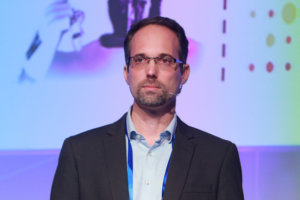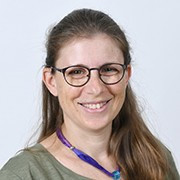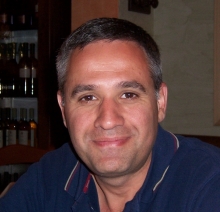
Fighting COVID with data and technology
Current and former BSF grantees show how data & technology play vital roles in fighting COVID-19
Along with its well-earned reputation as a scientific powerhouse, Israel is also recognized as a hub for data and technology. This is one of the reasons why Israel has earned the nickname “Start Up Nation.” And it’s one of the reasons why American scientists form successful partnerships with Israelis.
The world-wide spread of the Coronavirus laid bare the urgent need to combine the medical sciences with data and technology. Here are three examples of current and former BSF grantees who did just that – and had a profound impact on Israel’s pandemic response.
Ran Balicer

Balicer, a public health physician, manager and researcher, is Director of Health Policy Planning for Clalit, Israel’s largest health care organization. He is also the Founding Director of the Clalit Research Institute, which turns data into decision-making insights that can be translated into policies for transforming healthcare delivery and clinical practice. As part of that mission, Clalit established an integrated electronic health records (EHR) database, comprised of comprehensive clinical and administrative data since 2000, with some records dating back to the early 1990s. Clalit accesses the database to conduct research that addresses population-level health issues that have an impact on Clalit members.
Since the pandemic began, Balicer has helped oversee continuous, meticulous studies conducted by the Clalit Research Institute, focusing on the effectiveness of the Pfizer-BioNTech mRNA vaccine in the general Israeli population. (The Pfizer vaccine is the most common vaccine given to Israelis to protect against COVID-19.)
One study evaluated data on approximately 1.4 million Clalit members. According to results published in the New England Journal of Medicine, Clalit used advanced methodologies that employed meticulous individual matching techniques to enable an as-clean-as-possible analysis of vaccine effectiveness, comparing vaccinated to unvaccinated (control) individuals. Results made clear that the Pfizer vaccine is extremely effective, with 96 percent of symptomatic cases and 95 percent of severe cases prevented. The results also demonstrate that the vaccine is highly effective across all age ranges, with 92 percent effectiveness in preventing symptomatic disease in individuals 70 years and older.
For his BSF-funded project, Balicer is collaborating with Dr. Ronen Durst of Hadassah Hebrew University Medical Center and Joshua W. Knowles, assistant professor of cardiovascular medicine at Stanford University Medical Center, in an effort to identify Familial Hypercholesterolemia (FH) patients. FH is a common — but vastly underdiagnosed — inherited form of high cholesterol. Though potentially devastating if undiagnosed, FH can be successfully treated to prevent complications once it is diagnosed. The project aims to identify previously undiagnosed individuals with FH by going through electronic health records (EHRs) at Clalit, using a novel computer algorithm so that these patients and their families can receive potentially life-saving preventive care. This algorithm will be adapted from one created at Stanford University using machine learning techniques that have already been validated.
The pandemic has proven what Balicer and his Clalit team have known for years – that data and algorithms play an increasingly important role in disease management and treatment. In a well-received TED Talk, titled Medicine Transformed: The Algorithm Will See You Now, Balicer said Israel can rightly be called The Digital Health Nation because of its commitment to its technological innovation, its massive amounts of electronic health care records, and its universal health care system. “In Israel, there are more start-ups, medical patents, scientists and engineers than in any other country around the world,” he said.
While many science fiction novels and movies have propagated the idea that data and algorithms make medical care more impersonal, Balicer believes they can make patient care more personal – and successful – than it has been before.
“Algorithms are opinions embedded in code. And that’s not a bad thing if we can get the algorithm to look at the opinion of the patient and put it into account,” he said. “If we don’t do that, it’s the difference between precise and personalized – between medicine that looks at you as biology, and medicine that looks at you like a whole person.”

Dr. Adi Stern
Dr. Adi Stern is an evolutionary virologist at Tel Aviv University’s (TAU) School of Molecular Cell Biology and Biotechnology.
As part of a highly publicized study last year, Stern’s team worked with Clalit to use real-world data to determine the effectiveness of the BioNTech-Pfizer vaccine. While the study revealed a “slightly concerning” reduced effectiveness against the less dominant South African variant immediately post-second dose, Stern stated reassuringly, “Overall, our study suggests effectiveness of the vaccine remained very high at two weeks after the second dose against both variants.”
For her BSF-funded project, Stern is collaborating with Dr. Pleuni Pennings, an assistant professor at San Francisco State University. They have a joint NSF-BSF grant in environmental biology, where the pair are researching mutations in the HIV genome.
The human immunodeficiency virus (HIV) is responsible for one of the most devastating pandemics across the globe. While advances in medications have dramatically slowed the death rates in patients who would have probably succumbed to AIDS a generation ago, there is still no vaccine to stop HIV in the first place. Stern and Pennings hope to make inroads toward that goal.
Stern and Pennings seek to quantify the effects of every single mutation on the fitness, i.e., the ability to replicate, of HIV. They are doing this by developing both new statistical methodologies as well as new DNA sequencing technologies.
While there are obvious differences between the coronavirus and HIV (there is still no vaccine for HIV) they both continue affecting people all over the world, and they both continue challenging scientists by mutating. The coronavirus is further proof of the need to include new technologies and statistics into the study of viruses – just as Stern and Pennings are doing with their BSF-funded project.
Eli Waxman

When the pandemic hit Israel last year, former BSF grantee Eli Waxman, a professor at the Weizmann Institute of Science, worked with Israel’s National Security Council (NSC) team to create the plan for getting the country out of quarantine.
Waxman volunteered his services to the NSC, yet he is not a medical doctor or an immunologist. He’s a well-respected astrophysicist. Why would an astrophysicist do this? As Waxman said during a video interview with the Jerusalem Press Club last year, there were contradicting assessments in the pandemic’s early stages as to how serious – or not serious – COVID-19 would become in Israel. This led to widely conflicting messages about what Israel should do in response to the pandemic.
“At that point, I suggested to the NSC that it would be a good idea to form a team of experts whose main area of expertise is in analyzing very complex systems using data, and making solid, reliable assessments of the situation,” Waxman said.
The NSC took Waxman up on the offer, and he and his team went to work. Waxman analyzed the pace of vaccinations throughout Israel as well as the appearance of the new virus variants. While Israel’s vaccination roll out was impressive, especially compared with many other nations, Waxman cautioned that vaccinations alone would not prevent rampant spread – and that testing, tracing and isolating (with lockdowns if necessary) were needed to bring the virus under control.
Unfortunately, while the NSC accepted the team’s work and recommendations, the government did not implement them – leading to a serious new wave of the virus and further lockdowns.
Waxman has received two BSF grants, most recently in 2012, when he was part of a team of Israeli and American scientists involved in a four-year project, High Energy Neutrinos from Astrophysical Sources in the Era of Kilometer-Scale Neutrino Detectors. Their study focused on ultra-high energy neutrinos (UHEN) originated from Cosmic-Rays propagation (GZK neutrinos) and from Gamma Ray Bursts (GRBs), and their detectability in kilometers scale detectors. The team eventually developed a new, publicly accessible model for Askaryan radio emission from neutrino interactions that for the first time produces custom, fast analytical calculations of waveforms at both near- and far-field.
In 1999, he received one of BSF’s most prestigious honors for young scientists, the Bergmann Memorial Award, for his project Interaction of Gamma-Ray Bursts with their Surrounding Medium with Prof. Avi Loeb of Harvard University.
For Waxman, the pandemic has proven that the talents of astrophysicists can have implications far beyond the stars – or physics. While he laments the lack of implementation his recommendations received, he credits the Israeli government for being “ready to accept this kind of advice from experts, which is not a trivial thing at all,” he said.
